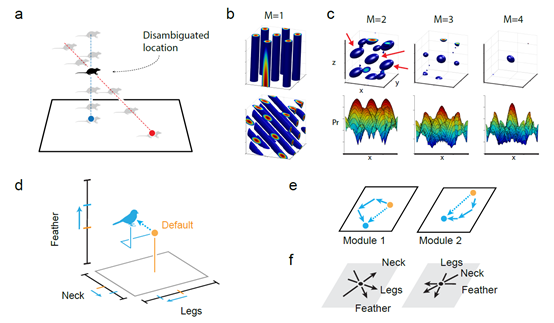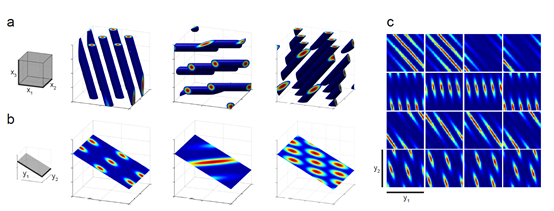
How grid cells generate unambiguous and high-capacity representations of variables in much higher-dimensional space?
Klukas, Mirko, Marcus Lewis, and Ila Fiete. “Flexible representation and memory of higher-dimensional cognitive variables with grid cells.” bioRxiv (2019): 578641.
The following content is from Klukas 2019.
Grid cell representations are simultaneously flexible and powerful yet rigid and constrained: On one hand, they can encode spatial or a variety of non-spatial cognitive variables (Constantinescu et al., 2016; Killian et al., 2012), with remarkable capacity, integration, and error correction properties (Fiete et al., 2008; Sreenivasan and Fiete, 2011; Mathis et al., 2012). On the other, states within each grid module are confined to a fixed two-dimensional (2D) set across time, environment, encoded variable (Yoon et al., 2013, 2016), behavioral states including sleep (Gardner et al., 2017; Trettel et al., 2017), with the inherent low-dimensionality etched directly into the physical topography of the circuit (Heys et al., 2014; Gu et al., 2018). The restriction to 2D states seemingly imposes a severe limit on the representation of general cognitive variables of dimension greater than two by grid cells.
Klukas et al. 2019 show that a set of grid cell modules, each with only 2D responses, can generate unambiguous and high-capacity representations of variables in much higher-dimensional spaces. Specifically, M grid modules can represent variables of arbitrary dimension up to 2M, with a capacity exponential in M. The idea generalizes our understanding of the 2D grid code as capable of flexible reconfiguration to generate unique high-capacity metric codes and memory states for representation and algebra in higher-dimensional vector spaces, without costly higher-dimensional grid-like responses in individual cells.

Fig. 4 Solution to the double ambiguity of grid cell representation: a three-dimensional example
Fig from Klukas et al. 2019.

Figure 6: Predictions about grid cell firing and cell-cell relationships in higher dimensions.
Fig from Klukas et al. 2019.
For further info, please read the paper Klukas et al. 2019.
Klukas, Mirko, Marcus Lewis, and Ila Fiete. “Flexible representation and memory of higher-dimensional cognitive variables with grid cells.” bioRxiv (2019): 578641.
About
Brain Inspired Navigation Blog
New discovery worth spreading on brain-inspired navigation in neurorobotics and neuroscience
Recent Posts
- How human, animals, robots encode and recall place?
- How the brain constructs time and space and how these are related to episodic memory?
- How environmental novelty modulate rapid cortical plasticity during navigation?
- How the Hippocampal Cognitive Map Supports Flexible Navigation?
- How the geometric structure and underlying circuit organization of hippocampal population dynamics facilitate both memory discrimination and generalization, enabling efficient and flexible learning?
Tags
Categories
- 3D Movement
- 3D Navigation
- 3D Path Integration
- 3D Perception
- 3D SLAM
- 3D Spatial Representation
- AI Navigation
- Bio-Inspired Robotics
- Brain Inspired Localization
- Brain-Inspired Navigation
- Cognitive Map
- Cognitive Navigation
- Episodic Memory
- Excerpt Notes
- Flying Vehicle Navigation
- Goal Representation
- Insect Navigation
- Learning to Navigate
- Memory
- Neural Basis of Navigation
- Path Integration
- Path Planning
- Project
- Research Tips
- Robotic Vision
- Self-Flying Vehicles
- Semantic Memory
- Spatial Cognition
- Spatial Cognitive Computing
- Spatial Coordinate System
- Spatial Learning
- Spatial Memory
- Spatial Resoning
- Time
- Unclassified
- Visual Cortex
- Visual Cue Cells
Links
- Laboratory of Nachum Ulanovsky
- Jeffery Lab
- BatLab
- The NeuroBat Lab
- Taube Lab
- Laurens Group
- Romani Lab
- Moser Group
- O’Keefe Group
- DoellerLab
- MilfordRobotics Group
- The Space and Memory group
- Angelaki Lab
- Spatial Cognition Lab
- McNaughton Lab
- Conradt Group
- The Fiete Lab
- The Cacucci Lab
- The Burak Lab
- Knierim Lab
- Clark Spatial Navigation & Memory Lab
- Computational Memory Lab
- The Dombeck Lab
- Zugaro Lab
- Insect Robotics Group
- The Nagel Lab
- Basu Lab
- Spatial Perception and Memory lab
- The Neuroecology lab
- The Nagel Lab
- Neural Modeling and Interface Lab
- Memory and Navigation Circuits Group
- Neural Circuits and Memory Lab
- The lab of Arseny Finkelstein
- The Epstein Lab
- The Theoretical Neuroscience Lab
- Gu Lab (Spatial Navigation and Memory)
- Fisher Lab (Neural Circuits for Navigation)
- The Alexander Lab (Spatial Cognition and Memory)
- Harvey Lab (Neural Circuits for Navigation)
- Buzsáki Lab
- Brain Computation & Behavior Lab
- ……